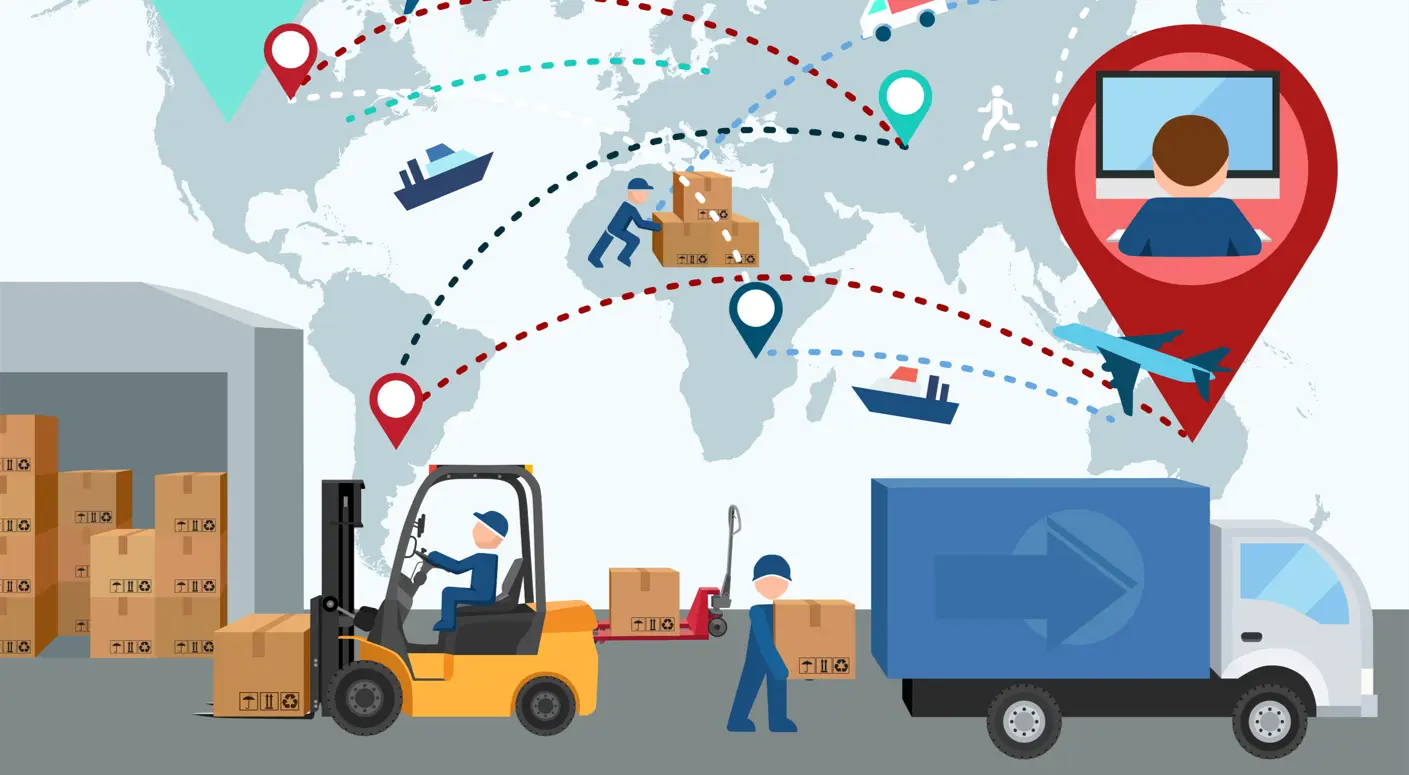
What Is Double Brokering in Trucking? Red Flags, Risks and Solutions
As the trucking landscape evolves and digital freight tools become more ubiquitous, the industry is seeing a sharp rise in scams that target brokers, carriers and shippers alike. Of those, double brokering has emerged as one of the most formidable.
In this guide, we’ll break down what double brokering is, how to identify the warning signs, what makes it illegal and which tools and strategies logistics teams can use to protect their operations.
The Growing Threat of Double Brokering
Double brokering has become one of the most pressing challenges in the trucking industry today. As freight volumes rise and digital load boards become more common, freight brokers and carriers face increased exposure to fraud.
At its core, double brokering is a deceptive practice that can result in lost shipments, payment disputes and insurance gaps. It creates confusion around the chain of custody and undermines the integrity of freight brokerage. As more scams surface and supply chain risk management becomes a priority, understanding and preventing double brokering is now a necessity for logistics professionals, especially freight brokers, compliance officers and trucking company managers.
These risks aren’t just theoretical; they’re affecting brokers, shippers and carriers every day across the U.S. freight ecosystem. The issue has gained attention due to a surge in trucking scams and carrier fraud reports. With tight truckload capacity and rising transportation costs, bad actors are exploiting vulnerabilities in digital freight matching platforms. This environment creates a ripe opportunity for double brokering scams, making it critical to proactively educate and protect the industry.
What Is Double Brokering in Trucking?
Double brokering occurs when a brokered load is re-brokered to another carrier—or worse, another broker—without the shipper’s consent. Instead of the original freight broker assigning a load to a vetted trucking company, an unauthorized middleman, often referred to as a double broker, intervenes.
This creates a hidden layer in the freight transaction, making it difficult to track the shipment or resolve issues. Often, the original broker believes the load is with a trusted carrier, but it has been handed off, leading to freight fraud, missed deliveries or even cargo theft. In many cases, neither the original broker nor the shipper knows the actual carrier until something goes wrong.
Double brokering is considered illegal under transportation regulations, especially when it involves deception, lack of transparency or misrepresentation. The Federal Motor Carrier Safety Administration (FMCSA) emphasizes that double brokering illegal activities can trigger regulatory penalties and civil litigation, particularly when loads are moved by unauthorized or unlicensed entities. In some cases, legitimate brokers may unknowingly hand freight to fraudulent entities, while in others, a malicious party poses as a carrier to gain access to load boards and reassign loads for profit.
According to the Transportation Intermediaries Association (TIA), double brokering fraud costs the industry hundreds of millions annually. To make matters worse, double brokered loads can end up uninsured, as the party hauling the freight may not be listed on any relevant policies. This can leave shippers and brokers responsible for losses if the freight is damaged, stolen or goes missing.
Why It’s a Serious Problem
What might start as a simple miscommunication or shortcut can quickly escalate into a serious liability. The consequences of double brokering freight extend far beyond operational headaches:
- Lost or stolen loads are common in fraudulent schemes.
- Insurance liability becomes unclear, often voided when unauthorized brokers are involved.
- Broker-carrier relationships suffer as trust erodes.
- Legal exposure may increase under FMCSA rules and transportation insurance policies.
- Payment disputes arise when multiple parties claim they are owed for a single shipment.
- Logistics compliance failures may trigger audits and fines for brokers and carriers.
Even worse, legitimate freight brokers may face broker-bond disputes, which can impact their credit and reputation. Carriers may also experience payment disputes if the double broker disappears after reassigning the load. These incidents can damage long-term client relationships and result in significant financial loss.
The lack of transparency in a double brokered load also creates a breakdown in the supply chain management process. Shippers rely on accurate load tracking and custody documentation to plan deliveries and protect against risk. When a load changes hands without notice, those safeguards collapse.
Common Warning Signs and Red Flags
Recognizing the early signs of double brokering is key to fraud prevention in trucking. Double brokering schemes often leave behind subtle but detectable clues—if you know what to look for:
- MC number mismatches or rapid MC number changes
- Carriers who avoid load tracking updates
- Inconsistent paperwork, such as multiple rate confirmations
- Unfamiliar carriers with no freight history accepting loads quickly
- Pressure to skip normal carrier vetting procedures
- Email addresses or phone numbers that don’t match company records
- Drivers showing up who are not on the carrier’s authorized list
- Requests to reassign the load after booking
Use FMCSA lookups to validate MC numbers and safety ratings and require signed documentation from the actual carrier hauling the freight. Document all communication and maintain a consistent record of each booking, including shipping contracts, rate confirmations and tracking logs. For additional tips, check out our guide on carrier vetting best practices.
How TMS and Tech Can Help Prevent It
Modern logistics tools play a powerful role in stopping trucking scams before they start. An advanced TMS (transportation management system) can:
- Offer centralized load visibility across all lanes
- Create audit logs to track carrier changes
- Provide auto-alerts when a new or risky carrier is assigned
- Integrate with freight fraud and trucking fraud detection tools
- Simplify digital paperwork with automated tracking
- Connect with ELD devices to verify carrier and driver data
- Generate exception reports when events deviate from expected behavior
- Incorporate AI to flag patterns of fraud, such as reassignments or repeated carrier anomalies
Revenova’s TMS for freight brokers fleets, and shippers offers many of these fraud-fighting features. With powerful integrations, these systems provide complete visibility into the full lifecycle of a shipment, from booking to delivery.
The right tech stack adds a critical layer of protection against fraud. Learn how CRM-powered freight tools and tech for freight safety can protect your team.
Steps to Protect Your Business
Protecting your logistics operation starts with tightening procedures and improving visibility. The following steps are essential:
- Vet every carrier with FMCSA lookups, document verification and risk scoring.
- Create onboarding checklists to ensure consistency in carrier approval.
- Monitor carrier behavior, especially frequent cancellations or sudden changes in routing.
- Use technology to detect unusual load reassignments.
- Educate staff on red flags and the steps to take if a scam is suspected.
- Avoid using carriers without verifiable contact details or insurance.
- Require drivers to submit live tracking updates or check-ins at specified intervals.
- Set clear expectations in all shipping contracts about unauthorized load transfers.
- Audit your carrier base regularly to flag dormant or suspicious activity.
- Update internal SOPs to include measures to prevent double brokering before a load is dispatched.
Building a fraud-resistant logistics operation is all about setting proactive safeguards into motion before risks arise. For more strategies, read our breakdown on how to prevent freight fraud.
Reduce Risk with Better Visibility
Double brokering threatens profitability, reputation and cargo safety. However, a combination of awareness, strict procedures and technology can help you stay ahead of scams.
Take action now:
- Educate your team on fraud prevention in trucking
- Leverage a 3PL logistics platform that tracks every step of a load
- Use TMS software with built-in transportation fraud detection and alert tools
- Monitor developments in logistics management and tech trends
- Maintain strong broker-carrier relationships by enforcing trust and transparency
Want to see how Revenova can help protect your freight? Book a freight protection demo today.




